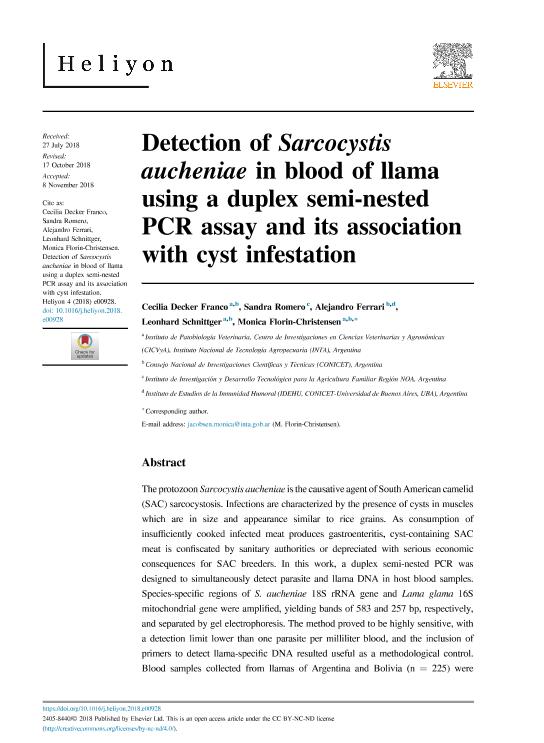Mostrar el registro sencillo del ítem
dc.contributor.author
Decker Franco, Cecilia

dc.contributor.author
Romero, Sandra Raquel

dc.contributor.author
Ferrari, Alejandro

dc.contributor.author
Schnittger, Leonhard

dc.contributor.author
Jacobsen, Monica Ofelia

dc.date.available
2022-07-15T14:07:57Z
dc.date.issued
2018-11
dc.identifier.citation
Decker Franco, Cecilia; Romero, Sandra Raquel; Ferrari, Alejandro; Schnittger, Leonhard; Jacobsen, Monica Ofelia; Detection of Sarcocystis aucheniae in blood of llama using a duplex semi-nested PCR assay and its association with cyst infestation; Elsevier Science; Heliyon; 4; 11; 11-2018; 1-13
dc.identifier.issn
2405-8440
dc.identifier.uri
http://hdl.handle.net/11336/162188
dc.description.abstract
The protozoon Sarcocystis aucheniae is the causative agent of South American camelid (SAC) sarcocystosis. Infections are characterized by the presence of cysts in muscles which are in size and appearance similar to rice grains. As consumption of insufficiently cooked infected meat produces gastroenteritis, cyst-containing SAC meat is confiscated by sanitary authorities or depreciated with serious economic consequences for SAC breeders. In this work, a duplex semi-nested PCR was designed to simultaneously detect parasite and llama DNA in host blood samples. Species-specific regions of S. aucheniae 18S rRNA gene and Lama glama 16S mitochondrial gene were amplified, yielding bands of 583 and 257 bp, respectively, and separated by gel electrophoresis. The method proved to be highly sensitive, with a detection limit lower than one parasite per milliliter blood, and the inclusion of primers to detect llama-specific DNA resulted useful as a methodological control. Blood samples collected from llamas of Argentina and Bolivia (n = 225) were analyzed using this method, and 18.7 % resulted positive for S. aucheniae. No correlation was found between PCR results and llama age, sex or the finding of macroscopic cysts in meat after slaughter. Lack of molecular detection in the blood of some llamas harboring macrocysts suggests that parasite circulation in the bloodstream after encystment is under the detection threshold of the test or even absent, while PCR positive results in cyst-infested animals suggests that prior exposure to the parasite does not impede subsequent infections. The described method can be useful to detect active foci of infection, to assess the effectiveness of parasiticide treatments, and for the surveillance and tracing of definitive hosts.
dc.format
application/pdf
dc.language.iso
eng
dc.publisher
Elsevier Science

dc.rights
info:eu-repo/semantics/openAccess
dc.rights.uri
https://creativecommons.org/licenses/by-nc-nd/2.5/ar/
dc.subject
MICROBIOLOGY
dc.subject
MOLECULAR BIOLOGY
dc.subject
BIOINFORMATICS
dc.subject.classification
Bioquímica y Biología Molecular

dc.subject.classification
Ciencias Biológicas

dc.subject.classification
CIENCIAS NATURALES Y EXACTAS

dc.title
Detection of Sarcocystis aucheniae in blood of llama using a duplex semi-nested PCR assay and its association with cyst infestation
dc.type
info:eu-repo/semantics/article
dc.type
info:ar-repo/semantics/artículo
dc.type
info:eu-repo/semantics/publishedVersion
dc.date.updated
2022-06-21T19:28:47Z
dc.journal.volume
4
dc.journal.number
11
dc.journal.pagination
1-13
dc.journal.pais
Países Bajos

dc.journal.ciudad
Ámsterdam
dc.description.fil
Fil: Decker Franco, Cecilia. Instituto Nacional de Tecnología Agropecuaria. Centro de Investigación en Ciencias Veterinarias y Agronómicas. Instituto de Patobiología Veterinaria - Consejo Nacional de Investigaciones Científicas y Técnicas. Oficina de Coordinación Administrativa Parque Centenario. Instituto de Patobiología Veterinaria; Argentina
dc.description.fil
Fil: Romero, Sandra Raquel. Instituto Nacional de Tecnologia Agropecuaria. Centro de Investigacion y Desarrollo Tecnologico Para la Agricultura Familiar. Instituto de Investigacion y Desarrollo Tecnologico Para la Agricultura Familiar Region Noa.; Argentina
dc.description.fil
Fil: Ferrari, Alejandro. Consejo Nacional de Investigaciones Científicas y Técnicas. Oficina de Coordinación Administrativa Houssay. Instituto de Estudios de la Inmunidad Humoral Prof. Ricardo A. Margni. Universidad de Buenos Aires. Facultad de Farmacia y Bioquímica. Instituto de Estudios de la Inmunidad Humoral Prof. Ricardo A. Margni; Argentina
dc.description.fil
Fil: Schnittger, Leonhard. Instituto Nacional de Tecnología Agropecuaria. Centro de Investigación en Ciencias Veterinarias y Agronómicas. Instituto de Patobiología Veterinaria - Consejo Nacional de Investigaciones Científicas y Técnicas. Oficina de Coordinación Administrativa Parque Centenario. Instituto de Patobiología Veterinaria; Argentina
dc.description.fil
Fil: Jacobsen, Monica Ofelia. Instituto Nacional de Tecnología Agropecuaria. Centro de Investigación en Ciencias Veterinarias y Agronómicas. Instituto de Patobiología Veterinaria - Consejo Nacional de Investigaciones Científicas y Técnicas. Oficina de Coordinación Administrativa Parque Centenario. Instituto de Patobiología Veterinaria; Argentina
dc.journal.title
Heliyon
dc.relation.alternativeid
info:eu-repo/semantics/altIdentifier/url/https://www.sciencedirect.com/science/article/pii/S2405844018342233
dc.relation.alternativeid
info:eu-repo/semantics/altIdentifier/doi/https://doi.org/10.1016/j.heliyon.2018.e00928
dc.relation.alternativeid
info:eu-repo/semantics/altIdentifier/url/https://www.cell.com/heliyon/fulltext/S2405-8440(18)34223-3?_returnURL=https%3A%2F%2Flinkinghub.elsevier.com%2Fretrieve%2Fpii%2FS2405844018342233%3Fshowall%3Dtrue
Archivos asociados
